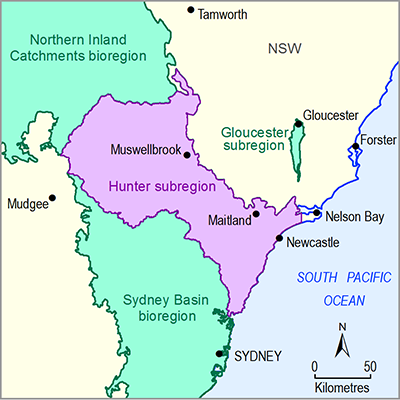- Home
- Assessments
- Bioregional Assessment Program
- Hunter subregion
- 2.6.1 Surface water numerical modelling for the Hunter subregion
- 2.6.1.1 Methods
- 2.6.1.1.4 Integration with sensitivity and uncertainty analysis workflow
Companion submethodology M09 (as listed in Table 1) (Peeters et al., 2016) discusses in detail the propagation of uncertainty through the numerical models in the bioregional assessments. The goal of the uncertainty analysis is to provide, for each hydrological response variable at each model node, an ensemble of the predicted maximum absolute and relative change and time to this change.
To generate these ensembles, a large number of parameter combinations of the combined groundwater and surface water model are evaluated. For each hydrological response variable, only those parameter combinations for which the goodness of fit between observed annual hydrological response variables and their simulated equivalent meet a predefined threshold are accepted in the posterior ensemble of parameter combinations.
While the Approximate Bayesian Computation methodology outlined in companion submethodology M09 (as listed in Table 1) for propagating uncertainty through models (Peeters et al., 2016) requires that this acceptance threshold be specified independently, preferably based on assessment of the observational uncertainty, this is generally not possible for the various surface water response variables. A pragmatic choice is made to set the acceptance threshold to the 90th percentile of goodness of fit for the large number of model evaluations. The ensemble of predictions for each hydrological response variable is thus based on the top 10% of parameter combinations for that hydrological response variable. The reasons for and implications of this assumption are discussed in Section 2.6.1.5.
The uncertainty methodology proposes the development of numerical emulators to mimic the relationship between parameter values and the response of hydrological variables due to the additional coal resource development to generate the posterior prediction ensembles. Due to the long model runtimes and the independently defined acceptance threshold, such emulators are used for the groundwater modelling to ensure a sufficiently large ensemble of predictions is obtained within the operational constraints to allow robust estimates of the 5th, 50th and 95th percentiles of the prediction ensemble.
For surface water modelling, creating emulators is not necessary as the pragmatic acceptance threshold ensures that, in the case of the 3000 model evaluations for the Hunter subregion, 300 (i.e. 10%) will be accepted in the posterior ensemble of predictions. Tests of this assumption suggest that this number is large enough to estimate the 5th, 50th and 95th percentiles robustly.

Product Finalisation date
- 2.6.1.1 Methods
- 2.6.1.2 Review of existing models
- 2.6.1.3 Model development
- 2.6.1.3.1 Spatial and temporal dimensions
- 2.6.1.3.2 Location of model nodes
- 2.6.1.3.3 Choice of seasonal scaling factors for climate trend
- 2.6.1.3.4 Representing the hydrological changes from mining
- 2.6.1.3.5 Modelling river management
- 2.6.1.3.6 Rules to simulate industry water discharge
- References
- Datasets
- 2.6.1.4 Calibration
- 2.6.1.5 Uncertainty
- 2.6.1.6 Prediction
- Citation
- Acknowledgements
- Currency of scientific results
- Contributors to the Technical Programme
- About this technical product
